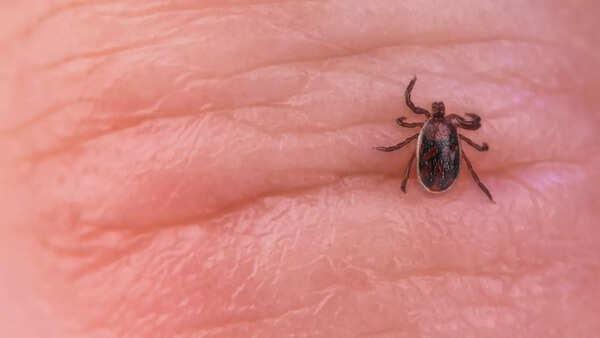Maria Palen, a 31-year-old chemical engineer from California, embodied peak fitness. With a dedicated plant-based diet and regular exercise, she amassed over 20,000 Instagram followers documenting her wellness journey. However, her story took a devastating turn when she was diagnosed with babesiosis, a parasitic infection transmitted by tick bites. By late 2024, she experienced paralysis from the waist down.

Maria's ordeal underscores the hidden dangers lurking even in seemingly healthy bodies and serves as a stark reminder of the potential severity of tick-borne illnesses, particularly for outdoor enthusiasts.
Initially, Maria experienced mild symptoms: inflammation, joint discomfort, and thumb pain. She attempted natural remedies, adjusting her diet and increasing her exercise regimen. Instead of improving, her condition deteriorated.
By March 2024, she was largely confined to bed. Everyday tasks became monumental challenges. Eventually, a specialist identified babesiosis, a relatively obscure tick-borne disease caused by Babesia parasites infecting red blood cells. Unlike Lyme disease, babesiosis often evades early detection due to its flu-like symptoms. The Centers for Disease Control and Prevention (CDC) reports a doubling of babesiosis cases in the past decade, rising from 1,000 in 2011 to approximately 2,500 annually.
Maria suspects the initial tick bite occurred years prior, possibly during a hike, and went unnoticed. The infection gradually progressed, ultimately impacting her nervous system. By October 2024, extreme tailbone pain prevented her from sitting, soon followed by paralysis.
Tick bites are frequently overlooked due to their small size and painless nature. A significant concern is the extended dormancy period some infections can exhibit. Maria's case highlights the limited awareness surrounding lesser-known tick-borne diseases such as babesiosis, not a lack of vigilance.
Ticks are most active during warmer months, flourishing in grassy and wooded environments. The 2024 tick season in the US was particularly severe, with milder winters leading to increased survival rates for tick-hosting animals. Researchers at the University of California, Riverside, warn that rising tick populations elevate the risk of rare infections spreading undetected.
The Babesia microti and B. duncani microbes responsible for babesiosis are difficult to detect as they reside within red blood cells. Recent genome research on B. duncani reveals similarities to the malaria parasite, explaining symptoms such as fever, chills, and muscle aches preceding more severe complications.

Maria's story is a testament to resilience in the face of adversity. Despite undergoing extensive therapy, she remains optimistic about regaining sensation in her legs. Her experience underscores the importance of early detection.
While Lyme disease is often the primary focus in suspected tick-borne illness cases, babesiosis is not always considered. Given the potential for co-infection, symptoms may be misattributed. Healthcare providers should adopt a broader diagnostic approach, and individuals should monitor for unexplained changes in energy levels, muscle strength, or chronic pain, especially after outdoor activities.
The risk extends beyond hiking and camping; even gardening in overgrown backyards or walking through wooded areas can pose a threat, particularly without protective clothing or tick repellents.
Beyond the standard advice of wearing long sleeves and checking for ticks, Maria's case calls for more comprehensive measures:
[This article is intended for informational purposes only and is not a substitute for professional medical advice. For any symptoms or health concerns, please consult a licensed healthcare provider]
Newer articles
Older articles
 Indian Astronaut Joins ISS: Shukla's Mission Ushers in New Era for India's Space Program
Indian Astronaut Joins ISS: Shukla's Mission Ushers in New Era for India's Space Program
 Ashada Gupt Navratri 2025: Unveiling Dates, Sacred Rituals & Hidden Significance
Ashada Gupt Navratri 2025: Unveiling Dates, Sacred Rituals & Hidden Significance
 Rishabh Pant's Unconventional Batting Redefining Cricket, Says Greg Chappell
Rishabh Pant's Unconventional Batting Redefining Cricket, Says Greg Chappell
 Moto G54 Price Slashed in India: Check Out the New, Lower Cost
Moto G54 Price Slashed in India: Check Out the New, Lower Cost
 JPG to PDF: A Graphic Designer's Guide to File Conversion and Quality Preservation
JPG to PDF: A Graphic Designer's Guide to File Conversion and Quality Preservation
 'The Traitors' Star Apoorva Mukhija Accuses Sudhanshu Pandey of Misogyny and Verbal Abuse After On-Screen Drama
'The Traitors' Star Apoorva Mukhija Accuses Sudhanshu Pandey of Misogyny and Verbal Abuse After On-Screen Drama
 Van der Dussen to Captain South Africa in T20I Tri-Series Against New Zealand and Zimbabwe
Van der Dussen to Captain South Africa in T20I Tri-Series Against New Zealand and Zimbabwe
 20 Minutes to a Healthier Brain and Heart: Neurologist's Simple Strategies to Combat Cholesterol, Blood Pressure, and Dementia Risk
20 Minutes to a Healthier Brain and Heart: Neurologist's Simple Strategies to Combat Cholesterol, Blood Pressure, and Dementia Risk
 England's Audacious Batters Claim They Could Have Chased Down 450 in First Test Win Over India
England's Audacious Batters Claim They Could Have Chased Down 450 in First Test Win Over India
 Popular Finance YouTuber "financewithsharan" Hacked: Security Measures to Protect Your Account
Popular Finance YouTuber "financewithsharan" Hacked: Security Measures to Protect Your Account